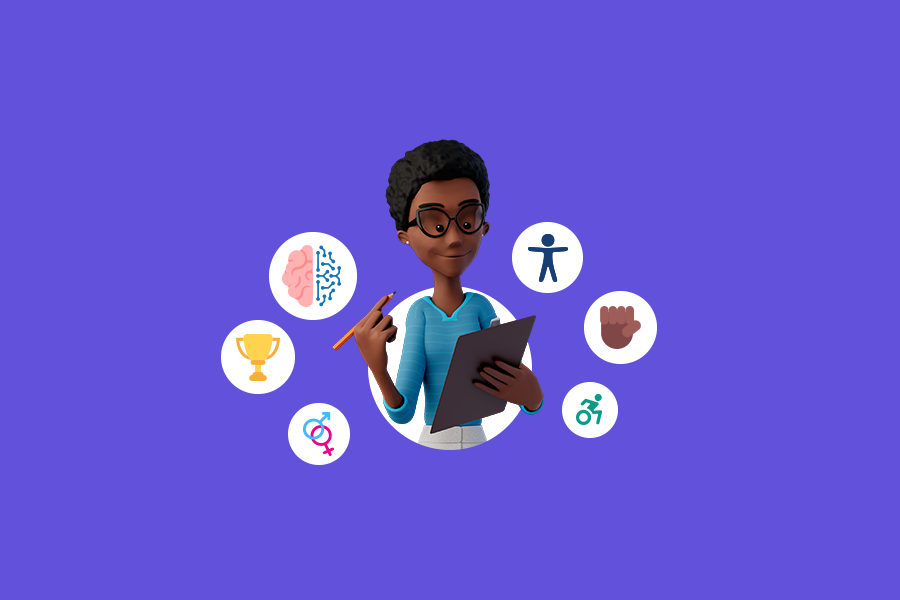
Technology and inclusion: importance and challenges

Technological evolution has transformed the way we live and work. However, do all individuals have equal access to these innovations?
Technology and inclusion are deeply interconnected. With this in mind, it is really necessary for us, as a society, to understand the importance of promoting inclusive environments in the technology sector and be prepared to address the challenges that present themselves. This is especially true when we think of people with disabilities.
According to the 2020 Web Accessibility Annual Report, only 2% of websites in the United States are accessible to people with disabilities. This is an incredibly low percentage, is it not? So, come learn more about this issue and understand your role in promoting more inclusion within technology.
The importance of inclusion in the technology market
Diversity is an essential driver for innovation and progress, extending beyond just the aspect of social justice. By including professionals from diverse backgrounds and skills, the market enriches itself with different perspectives, stimulating creativity and effective problem-solving.
Besides, embracing inclusion allows technology companies to expand their reach and relevance, serving a more extensive and representative user base, promoting a fair and equitable environment.
Last, but definitely not least, stimulating a market that values inclusion opens up space for the creation of digital products and solutions designed to cater to increasingly larger groups of people. This more comprehensive and efficient approach benefits society as a whole, including individuals with and without disabilities.
Inclusion through technology
The proper application of technology emerges as a super important driver for promoting inclusion. Adaptive software and devices, often known as assistive technologies, not only represent technological advancements but also have the power to break down barriers, providing equitable opportunities for everyone.
From accessibility apps aimed at making information more accessible to innovative communication technologies that expand interaction possibilities, these innovations have been fundamental in easing the lives of people with disabilities.
This technological transformation is not only restricted to personal aspects but is a significant advance in ensuring the full participation of people with disabilities in today’s society and job market. It is responsible for promoting lives with more independence and autonomy for this part of the population.
What are the challenges for the inclusion of people with disabilities in the technology sector?
Despite being in continuous evolution, the inclusion of people with disabilities in the technology sector faces various challenges, ranging from physical barriers to issues of awareness and stigmatization.
One of the main difficulties lies in architectural and technological barriers in workplaces and the online world in general, which can limit accessibility for people with disabilities. Also, a lack of awareness about the specific needs of this group can result in non-inclusive environments.
The stigma associated with disabilities is also an obstacle, often leading to prejudices and discrimination, known as ableism. The absence of inclusive practices in hiring policies and organizational culture also contributes to the underrepresentation of people with disabilities in the sector.
To overcome these challenges, we need to have a holistic approach, involving awareness, physical and technological adaptations, and inclusive policies that value and promote diversity!
The role of technology companies in promoting inclusion
The role of technology companies in promoting inclusion is super important, ranging from implementing inclusive policies to actively developing assistive technologies.
First of all, companies have the responsibility to create inclusive work environments, involving the adoption of hiring practices that value diversity and the promotion of an organizational culture that celebrates differences. Besides, they play an essential role in the development of assistive technologies, creating solutions that meet the specific needs of people with disabilities.
Investing in training and awareness for employees is equally important, ensuring that everyone understands and respects the needs and contributions of people with disabilities.
Lastly, technology companies have the power to lead the way to a more inclusive society, serving as examples of best practices and driving social innovation!
How to create an inclusive work environment?
Creating an inclusive work environment is not difficult but requires commitment, addressing different aspects of the company. Here are some key strategies:
Inclusive hiring policies
- Implement hiring policies that value diversity;
- Conduct training to ensure the recruitment team is aware of inclusive selection best practices.
Physical and technological adaptations
- Make physical adjustments to ensure accessibility, such as ramps, elevators, and adapted bathrooms;
- Develop or adopt technologies that facilitate work for all individuals, regardless of their abilities.
Organizational culture
- Foster a culture that celebrates diversity and promotes acceptance;
- Implement training programs for awareness of diversity and inclusion issues.
Assertive and accessible communication
- Ensure information is communicated assertively and accessibly to all employees;
- Use diverse communication formats, including visual, written, and oral materials.
Team participation
- Encourage active participation of all team members in events, meetings, and organizational decisions;
- Establish forums and a diversity committee to receive feedback on workplace inclusion.
Continuous training
- Provide ongoing training for all employees, addressing topics related to inclusion and diversity;
- Encourage learning about different perspectives and experiences of colleagues.
Flexibility policies
- Implement flexible policies, such as adjustable working hours and remote work options, to accommodate individual needs.
Access to support resources
- Provide support resources, such as translation services, Sign Language interpreters, or assistive technologies, as needed.
Encouragement of collaboration
- Create opportunities for collaboration and interaction among colleagues, promoting a sense of community and belonging.
Continuous evaluation and adjustments
- Regularly evaluate policies and practices to ensure they align with inclusion objectives;
- Create an open environment for making continuous adjustments and improvements based on team feedback.
What is the relationship between technology and accessibility?
The relationship between technology and accessibility is essential to ensure that technological innovations are accessible to all individuals, regardless of abilities or limitations.
Accessibility in the technological context refers to the creation of products, services, and virtual environments that can be used and understood by people with different abilities and needs. Some of the key areas that we can observe regarding this relationship include:
Inclusive design
Develop products and interfaces that are intuitive and easy to use for a variety of users, considering different interaction modalities and promoting a good user experience.
Assistive technologies
Integration of assistive technologies, such as screen readers, voice recognition software, adaptive keyboards, and virtual Sign Language translators, providing additional support for people with disabilities to interact with devices and applications autonomously.
Accessibility in digital platforms
Ensure that websites, applications, and digital platforms are designed in compliance with accessibility standards, such as WCAG, making them usable by everyone, regardless of their abilities.
Interface adaptation
Allow interface customization, such as adjustable font sizes, alternative color schemes, and other settings that meet the individual preferences and needs of different users.
Accessible communication
Develop accessible communication solutions, including video captions, audio transcriptions, and translation tools for Sign Languages.
Accessible Internet of Things (IoT)
Integrate accessibility principles into IoT devices to ensure that all functionalities can be used by individuals with diverse abilities.
Accessible virtual and augmented reality
Develop virtual and augmented reality experiences that are accessible, considering specific needs such as sound navigation or tactile interfaces.
Training and awareness
Provide training and awareness programs for technology professionals on the importance of accessibility, encouraging the incorporation of these principles from the early stages of development.
Legislation and standards
Adherence to international standards and legislation requiring the incorporation of accessible practices and technologies, such as the Americans with Disabilities Act.
Hand Talk and the union of technology and accessibility
Here at Hand Talk, we also unite technology and accessibility for the social good. Using Artificial Intelligence, we offer a digital accessibility plugin that automatically translates texts into Sign Languages, along with other assistive features for individuals with visual and cognitive disabilities, for example.
Our mission is to break down communication barriers through technology, a significant example of how technology can be a powerful ally in promoting inclusion, facilitating communication, and understanding between different communities.
Conclusion
In a world driven by constant technological evolution, we need to reflect on the equality of access to these innovations. The relationship between technology and inclusion is not just a theoretical and abstract concept but a practical necessity in building a more equitable and diversified future.
Each person has a super important role to play in ensuring that the technological revolution is truly inclusive, promoting equal opportunities, and enriching society as a whole!
Ready to start your digital inclusion journey? Then come learn more about the Hand Talk accessibility plugin. Talk to our team of experts right now!


